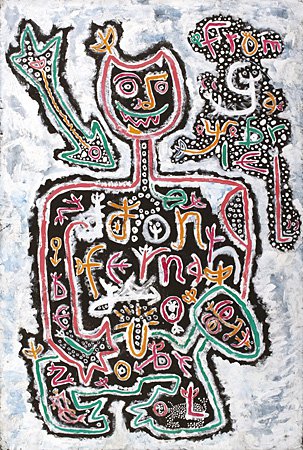Cultural Center of the Philippines
ENCYCLOPEDIA OF
PHILIPPINE ART
[Portrait of Fernando Zobel]
1956 / Tempera on board / 91.44 x 62.23 cm / Artist: David Cortez Medalla / Cultural Center of the Philippines collection
Medalla is best known for his Bubble Machines, but this small work represents his initial pursuit of art out of the ordinary. It rejects volume and instead stresses the two-dimensionality of the painting surface by means of flat linear figures. Its influences are children and primitive art, with a strong Dadaist strain and an affinity with Art Brut, mocking the seriousness of high art and introducing the element of play, features that would increasingly come out in Medalla’s other works.
The subject of the portrait, Fernando Zobel, an eminently dignified figure in the arts, is here deconstructed and converted into a spontaneous and irrational, yet charming icon with a grinning head. His torso is filled with all kinds of characters, symbols, emblems, and masks. There are design areas on both sides, one of which contains the letters “From Gaybriel,” the sobriquet with which Medalla signs his works in this series. The influence of Art Brut is seen in the scratching or sgraffito technique, which produces irregular outlines and mottled textures. The playful, childlike appearance of the characters also creates a decorative effect.
This work belongs to Medalla’s first solo exhibition of predominantly large canvases on which he applied oil mixed with seashells, gravel, and sand. Starting with The Unicorn, 1956, Medalla used strong and steady lines to delineate the figure as a single, large subject, surrounding this with colorful ideograms. Other figures in tempera on paper follow in this vein. His subjects are smiling broadly and devoid of personality, with only titles to identify them: Self-Portrait, 1957, now in the National Museum; Imagining the Portrait of Fernando Zobel, 1956, the second Zobel portrait in the Cultural Center of the Philippines; and My Sister Bingkutay at the Sewing Machine and The Joyous Kingdom, 1956 and 1957, respectively, in the Ateneo Art Gallery collection. The last mural, comprised of multiple figures, Zobel purchased and donated to the Ateneo Art Gallery along with his Philippine contemporary art collection.
Medalla celebrated texture, color, and line in this series. Like the 1940s paintings by Jean Dubuffet (1901–85) and Jean Fautrier (1898-1964) of the School of Paris, thick impasto served as skin for Medalla’s figures. Reviews of Medalla’s first exhibition were largely laudatory: art writer Joan Edades called his naive and brazen style “a milestone in Philippine art” and poet Jose Garcia Villa hailed him in equally superlative terms. Three years on, Medalla would leave the country and return only rarely, but he never gave up his Philippine passport. Presenting innovative concepts that challenged the commerce of art and the notion of permanence in sculpture, he went on to experiment with machines, the human body, and people’s psyches. Today he is viewed as a leading transnational avant-garde in the recovered history chapters of Kinetic Art (1962-66), Participation Art (1969 to mid-1970s), and Performance Art (1978-present). Throughout these periods, he would continue to draw and paint and organize the renegade and avowedly inclusive London Biennial.
Written by Alice G. Guillermo and Purissima Benitez-Johannot
Source
Benitez-Johannot, Purissima.2012b. “Origins: Medalla in the Fifties.” In The Life and Art of David Medalla, edited by Purissima Benitez-
Johannot, 4-23. Quezon City: Vibal Foundation Inc.
